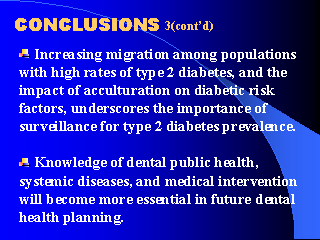|
|
|
|
front |1 |2 |3 |4 |5 |6 |7 |8 |9 |10 |11 |12 |13 |14 |15 |16 |17 |18 |19 |20 |21 |22 |23 |24 |25 |26 |27 |28 |29 |30 |31 |32 |33 |34 |review |
 |
According to the World Health Organization (WHO) diabetes mellitus is now the
most common endocrine disease in the world and its prevalence is rising. By the
year 2000 more than 300 million persons worldwide will be affected by diabetes
mellitus. Type 2 Diabetes Mellitus (Type 2 DM), which is characterized by
defects in both insulin secretion and action, accounts for the greater part of
cases of diabetes. It is one of the leading causes of death and a significant
risk factor in the development of coronary heart disease and cerebrovascular
disease as well as peripheral vascular disease, nephropathy (kidney disease),
neuropath (nerve disease), and retinopathy (eye disease).
Moreover, diabetes mellitus and in particular Type 2 DM a non-communicable disease, is a major public health problem affecting certain ethnic groups. The prevalence that increases with age is particularly high among women over age 40. A Mexican-American target population along the United States-Mexico border has been presented to assess the oral manifestations of Type 2 DM and to determine the diabetic risk factors affecting the population and which impact on dental public health. This geographic area is home to a high percentage of people of Mexican origin or ancestry. A global overview of the American Southwestern region/border public health issues and concerns has been used to provide the context in which the population lives, and where the disease emerges and is maintained. The specific aim of the lecture/presentation was to examine the oral manifestations of Type 2 DM among older people of Mexican-American ancestry living along the US-Mexico border, particularly in the Texas-Mexico border region, a segment of a population at risk on which this particular aspect of Type 2 DM has not been addressed. The lecture attempted to provide an insight as to the magnitude of the impact of Type2 DM on dental public health as well as contribute further to the understanding of the oral manifestation patterns related to the high prevalence of Type 2 DM in this particular segment of society and the relative role played by different risk factors. In the sections that went before, the lecture discussed/presented in detail the high prevalence of Type 2 DM in the Mexican-American population and the dental public health implications of diabetes that impact on this at-risk and underserved United States-Mexico border population. |